Are you looking for a “Because I could not stop for Death” analysis? That’s fantastic, because you’ve come to the right place. We have the best analysis of this haunting Emily Dickinson poem that you are going to find anywhere!
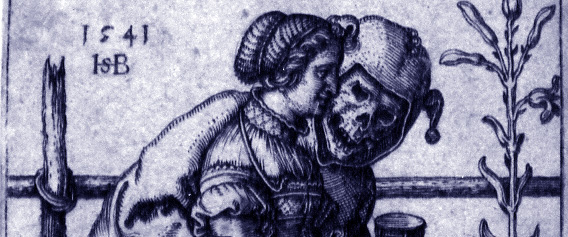
Because I could not stop for Death: analysis of background
We begin our poem analysis by noting that “Because I could not stop for Death” is a particularly famous poem by Emily Dickinson. It was probably written in 1863, which was also the third year of The American Civil War—a time when many young men were dying every year in a protracted war.
While Thomas Johnson numbers this Dickinson’s 712th poem, R. W. Franklin estimate is that it was Emily Dickinson’s 479th poem.
The poem was initially published in 1890 under the title, the Chariot. The name the Chariot was never intended for the poem, but assigned by Thomas Wentworth Higginson. The original published version left out the fourth stanza and in other ways similarly butchered the poem. Despite this, the Chariot soon became a classic after its publication.
Of course, we should note that “Because I could not stop for Death” was also never intended as a name for the poem. The current practice for Emily Dickinson’s poetry is simply to use the first line as a title. Any poem analysis should not read anything into the title.
Some have suggested “Because I could not stop for Death” was inspired by a real-life incident. Emily Dickinson’s close friend Was Eliza M. Coleman. Coleman’s older sister Olivia Coleman actually did die in a carriage ride of a tubercular hemorrhage.
Others have suggested that “Because I could not stop for Death” is a reenactment of the age old myth of a young woman abducted by Death, such as in the classical myth of Persephone. Still others have noted the poem is reminiscent of a motif that goes back at least to the middle ages known as “Death and The Maiden.”
We recommend you check out the original manuscript of the poem, which can be found here: “Because I could not stop for Death”
Because I could not stop for Death, analysis of each stanza
We think the best way to approach a “Because I could not stop for Death” analysis is by going through each stanza of the poem. We’ll offer a variety of potentially unrelated comments. Our purpose is not to state anything too forcefully, but instead to inspire you with your own possible interpretations. In this way, you can perhaps come up with your own unique poem analysis.
Because I could not stop for Death, analysis of stanza one
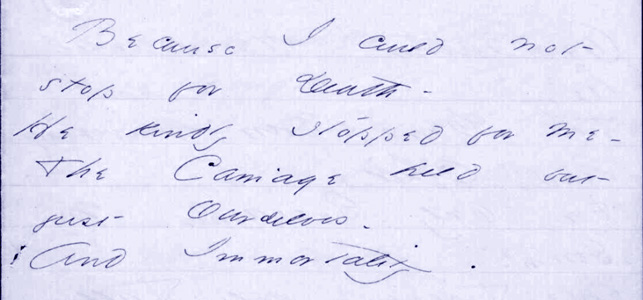
Because I could not stop for Death –
He kindly stopped for me –
The Carriage held but just Ourselves –
And Immortality.
Our analysis first notes that the first two lines above can potentially be read with sarcasm. What can it possibly mean to say that death stops to call on us? How does Emily Dickinson want us to read this? How seriously does she want us to read the first two lines given that she starts this way?
The poem was written in the middle of the 1800s, so this impacts how we might want to view the poem. We can easily imagine a male suitor coming to call on a female interest this way. She’s been too busy, so he’s come personally to call on her. Why compare death to a male suitor? What are the implications of this? Is marriage or even sex being compared to death? If so, why?
Could the carriage be viewed as a hearse?
Should immortality be regarded as a third passenger? Or is it that both death and the narrator are now immortal? There is an ambiguous twist that needs to be explored. We should discuss this a bit more.
Mortality is a reference to death. Immortality is the absence of death. So can we say that both death and the absence of death are in the carriage? How can that be? Is it that death is eternal, therefore immortal? Think about it the following way. Life is limited. We are mortal. However, once we die, in a sense do we become immortal? Death, after all, is forever.
Could the reference to immortality be in reference to heaven? Perhaps, but the narrator would not seem to be in heaven, would she? Is death here a negative event or a positive one?
Consider again the first line. The narrator could virtually be anyone, right? After all, who is ready for death? Death just drops by and then that’s it, isn’t it? It doesn’t matter at all how busy we are.
Because I could not stop for Death, analysis of stanza two
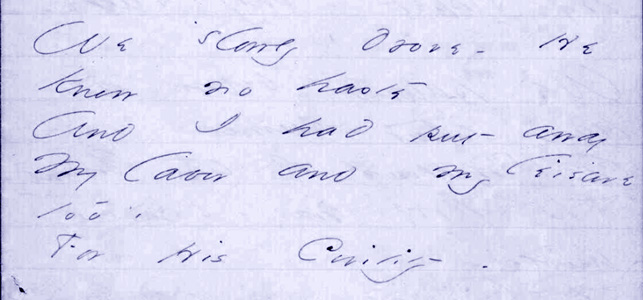
We slowly drove – He knew no haste
And I had put away
My labor and my leisure too,
For His Civility –
Any “Because I could not stop for Death” analysis should remark that we tend to see death as something scary. Who wants to die? If that’s the case, then why does the situation in the poem come across as happening in such a calm manner? There isn’t a hint of panicking, just the laying aside of things, and then moving forward into death.
Life is busy and full of labor. With what time is left after that we attempt leisure. Is there anything else to life but labor and leisure? Is death then the absolute absence of these things?
Why is death so civil? What does death’s politeness tell us about him? Death is often portrayed as a dark, silent, grim reaper. But in this poem, death is a calm, polite, male suitor taking a young lady for a carriage ride. Are we to believe this is the true nature of death? Or is it simply that the young lady is being deceived, perhaps even seduced by death?
Because I could not stop for Death, analysis of stanza three
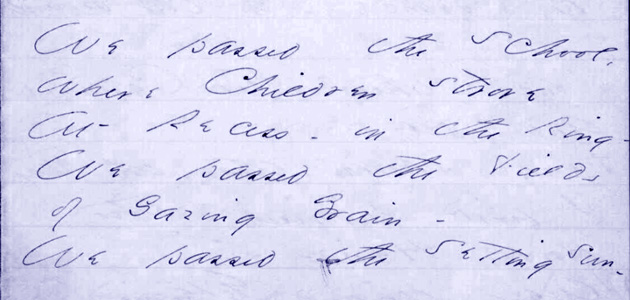
We passed the School, where Children strove
At Recess – in the Ring –
We passed the Fields of Gazing Grain –
We passed the Setting Sun –
In stanza three of “Because I could not stop for Death” we appear to cover four stages of life. We’re reminded of the famous Shakespearean monologue in As You Like It: All the World’s a Stage.
We first have children representing youth, then ripe grain representing adulthood, and then finally the setting sun representing old age. We travel through an entire lifetime in the course of four lines!
What is the significance of the children being at recess? Is there a connection here with leisure? Could children perhaps suggest innocence? There’s something gripping and nostalgic about the image of children so close to the image of death. Perhaps children here portend death. They are a sign to the narrator of her own age. She has gotten old and is going to be superseded by the next generation.
But of more significance for any poem analysis must be the reference to the ring. This could easily be interpreted as a reference to the cycle of life—youth, middle age, then old age. But going back to the beginning of the poem, consider that Death was a male suitor calling on a young lady. Could the Ring be an engagement ring? Or perhaps a wedding ring?
In the first and second stanza, death was related to courtship, and now we’re getting allusions to marriage.
Because I could not stop for Death, analysis of stanza four
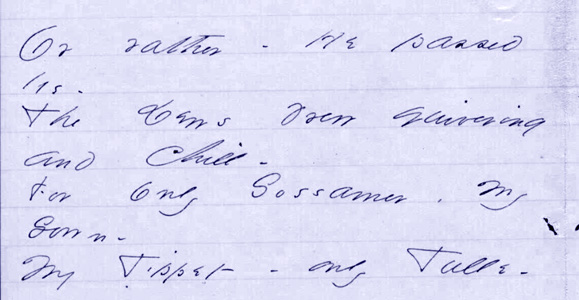
Or rather – He passed Us –
The Dews drew quivering and Chill –
For only Gossamer, my Gown –
My Tippet – only Tulle –
Our “Because I could not stop for Death” analysis has to stop here and ask, what does it mean to say that the sun passed them? There are different possibilities. As we’ll learn below, perhaps the narrator has been buried in a grave, and the sun can be seen as passing over them. On a deeper level, we talked about the cycle of life above; The narrator has stepped out of this cycle into death.
While we often associate dew with morning, dew can also appear in the early night. Night clearly can be a reference to the time we sleep, sleep here being death. Death is cold, the body is no longer warm.
The description of clothing is worth paying particularly close attention to. First, why is the narrator not dressed more warmly? Well, a dead body doesn’t require warm clothes does it?
Even more unsettling is this, consider the clothing, a gown and a tippet. A tippet is basically a shawl. So the narrator is basically referring to a bridal gown and bridal shawl. The materials here only further corroborate this. The gown is of gossamer, and the tippet is made of tulle. So what gives here?
In the first and second stanza of the poem death was a suitor. In the third stanza we had a reference to an engagement ring, and now, we find the narrator dressed as if for a wedding! Is this poem about death or about marriage?
This stanza is obviously very important for any analysis of the poem. Now step back and consider that in the initial publication of “Because I could not stop for Death” stanza four was deleted. Considering what we’ve been discussing, do you think this was a wise decision?
Because I could not stop for Death, analysis of stanza five
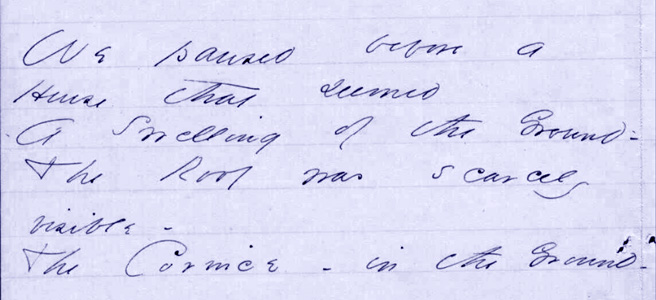
We paused before a House that seemed
A Swelling of the Ground –
The Roof was scarcely visible –
The Cornice – in the Ground –
Let’s review our “Because I could not stop for Death” analysis so far. Stanza one and two are about courtship. Stanza three is about engagement. Stanza four is a wedding ceremony. So what is stanza five? Apparently it is the happy couple crossing the threshold into their new home.
But what home is this? We don’t think there can be any doubt that it is a grave. The idea of a roof and a cornice might sound a bit off, but this might be in reference to a particular type of early American burial vault, not just a coffin buried in the ground. For example take a look at some of these graves.
Because I could not stop for Death, analysis of stanza six
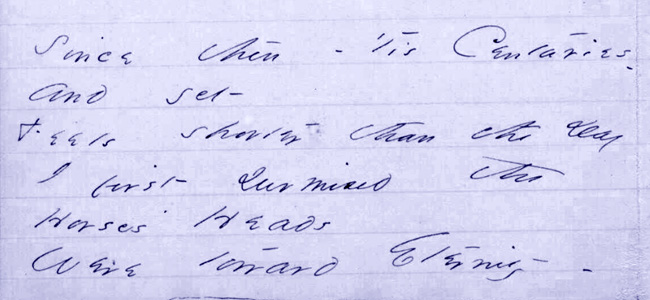
Since then – ’tis Centuries – and yet
Feels shorter than the Day
I first surmised the Horses’ Heads
Were toward Eternity –
This entire stanza can probably be read as a denoument.
In the final stanza of “Because I could not stop for Death”, the narrator reveals that all the previous stanzas are but memories. Centuries have gone by since then, though the time that has passed feels shorter than the day. If it wasn’t painfully obvious from the beginning, we now get confirmation that the narrator is dead.
For the beginning of our poem analysis we knew we were dealing with death from the beginning. After all, the narrator said it was death that came calling. However, did the narrator recognize death at first? We get a sense reading this stanza that it was only after the events of the first four stanzas that the narrator realized their significance—that this was death, and it was final.
We think the reference to horses heads is of particular interest here. Consider something that Carl Jung states about horses in his magnum opus, Symbols of Transformation, “The sexual nature of the devil is imparted to the horse as well, so that this symbol is found in contexts where the sexual interpretation is the only one that fits. Loki propagates in the form of a horse, and so does the devil, as an ancient god of fire.”
Here the horse is both related to the devil and to an act of sexual intercourse. The image of the devil appearing is no surprise, after all, the narrator has died. But why the act of sex? Consider what we’ve been stating all along.
To restate it yet one more time. Stanza one and two are about courtship. Stanza three engagement. Stanza four is marriage. Stanza five is crossing the threshold into the new home. Stanza six is sexual consummation of the marriage.
Because I could not stop for Death, analysis of mythological motifs
Many poem analyses have suggested that Emily Dickinson’s poem, “Because I could not stop for Death” is a retelling of the story of Persephone.
There are clear similarities between the poem and this Greek myth. Death can be seen as taking on the role of Hades. He seduces or outright rapes Persephone and then takes her to the Greek underworld to live as his Queen. Persephone’s mother, Demeter, is devastated. Demeter is the goddess of the grain, and so devastated is she, that everything begins to die. When Persephone is restored to Demeter, again the flowers bloom and the wheat grows. However, as Persephone has eaten the fruit of the Underworld, she has to return to the Underworld four months out of the year. These months become the winter season. Thus, the cycle of the seasons begins.
This myth has an important history and its theme is one repeated in several contemporary and older myths. These myths in turn inevitably had an influence on early Christianity.
So is Emily Dickinson fashioning her own version of this prevalent and ancient myth? We know that she had classical training including the study of Latin. It’s not hard to imagine she’d been exposed to the myth of Persephone. Moreover, the poem basically takes us through the rites of marriage. The poem even ends with a reference to the sexual consumption of this marriage. Within the poem, there is a reference to wheat ready to be harvested, which can be seen as a reference to Demeter, Persephone’s mother. We also have the reference to the cycles of life in stanza three.
If Dickinson is retelling the myth then why the differences? Here there is no sudden rape, but a gentle courtship. Moreover, death seems final. Though there is a reference to immortality in the first stanza, death seems final and irrevocable, an eternal state. Persephone rises and dies according to the cycle of the seasons. Jesus rises from the dead and promises a future life to those who follow him in heaven. There is no sense of this in “Because I could not stop for Death.” Instead, the narrator appears to have stepped completely out of this cycle.
For those who want to view “Because I could not stop for Death” as a retelling of the Persephone myth, then these differences need to be explained.
Because I could not stop for Death, analysis of meaning
If you’ve followed our “Because I could not stop for Death” analysis this far, then perhaps you can already guess what our own final analysis will be. Before we give this interpretation we’ll first explain what we don’t think the poem is about.
We do not think the poem is using death as a metaphor for marriage. Still, we think this would make for an interesting interpretation. After all, what did Emily Dickinson think of marriage? It’s notable that she never married. Could she have seen marriage as a kind of death? And could the poem really be about marriage and not death at all? The dominant idea here would be that marriage is a way of dying. We put on society’s role for us, its expectations, then we lose our own individuality, becoming part of a bigger, interpersonal cycle. The end result of this cycle being our own death. Thus, marriage could be seen as the first domino falling on a path that leads irrevocably to death and away from individual existence.
While the above analysis carries a certain fascination for us, we do not think it does justice to the poem. Instead, we think the poem actually is about death. While we do not think Dickinson is trying to retell the myth of Persephone, we do not see any reason why she could not have taken it as a starting point, a point of inspiration. But what Dickinson wants to say about death is quite different.
Dickinson is speaking in a lovingly about death. In “Because I could not stop for Death” marriage is a positive and reassuring metaphor for death. We are assured that death is not only a part of life but something not to be feared.
Death doesn’t seduce us but it comes to us as gentle as a polite suitor. And isn’t it only death that helps us appreciate us the cycles of life? But the cycles of life are relentless, and death is seen as a means of escape. It is a final resting point. Death is coming, and it need not be feared so much as welcomed.
Is there more to “Because I could not stop for Death” than such an analysis would suggest? We hope you’ll think so, and try your hand at your own analysis. In that case, please let us know what you come up with!
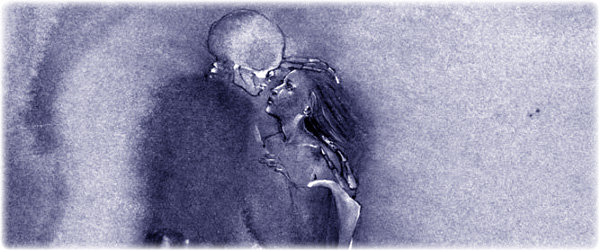
We hope you enjoyed this “I could not stop for Death” analysis. We hope it inspires you to make your own unique poem analysis. Don’t forget to subscribe to our poem updates!